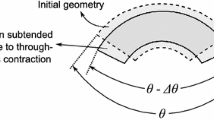Abstract
Autoclave consolidation is used to manufacture continuous fiber composites in applications that have strict part porosity requirements. The applied positive pressure in this process is attractive for reduction in part porosity. However, some part geometries can cause porosity issues even under positive pressure. One is the concave corner seen in an L-bracket geometry. Higher porosity is seen in areas of high curvature, hindering part quality. Since the autoclave process takes several hours and prepreg material is expensive, trial-and-error methods of resolving issues are not practical. In this work, a unique physics-based viscoelastic model is proposed to describe the mechanical behavior of uncured continuous fiber thermoset prepreg undergoing consolidation under hydrostatic pressure. This model considers stress due to compaction of the fiber network, compression of voids in the resin, and viscous stress from resin flow relative to fibers. The constitutive expressions for these are coupled to important mechanisms that occur during autoclave consolidation. The viscoelastic model is incorporated into the finite element analysis software ABAQUS/Standard using a UMAT subroutine. Numerical results are validated by analytic solutions and experimental comparison for flat and L-bracket geometries. A parametric study identifies important process and material parameters that influence the quality of the manufactured part.























Similar content being viewed by others
References
Hassan MH, Othman AR, Kamaruddin S (2017) A review on the manufacturing defects of complex-shaped laminate in aircraft composite structures. Int J Adv Manuf Technol 91:4081–4094. https://doi.org/10.1007/s00170-017-0096-5
Hubert P, Poursartip A (1998) A review of flow and compaction modelling relevant to thermoset matrix laminate processing. J Reinf Plast Compos 17:286–318
Li M, Li Y, Zhang Z, Gu Y (2008) Numerical simulation of two-dimensional flow and compaction during the consolidation of laminated composites. Polym Compos 29:560–568. https://doi.org/10.1002/pc.20444
Li Y, Li M, Gu Y, Zhang Z (2009) Numerical and experimental study on the effect of lay-up type and structural elements on thickness uniformity of L-shaped laminates. Appl Compos Mater 16:101–115. https://doi.org/10.1007/s10443-009-9080-z
Li M, Tucker CL III (2002) Modeling and simulation of two-dimensional consolidation for thermoset matrix composites. Composites: Part A 33:877–892. https://doi.org/10.1016/S1359-835X(02)00017-9
Shuler SF, Advani SG (1996) Transverse squeeze flow of concentrated aligned fibers in viscous fluids. J Nonnewton Fluid Mech 65(1):47–74
Baran I, Cinar K, Ersoy N, Akkerman R, Hattel JH (2017) A review on the mechanical modeling of composite manufacturing processes. Arch Computat Methods Eng 24:365–395. https://doi.org/10.1007/s11831-016-9167-2
White SR, Hahn HT (1992) Process modelling of composite materials: residual stress development during cure. Part I. Model formulation. J Compos Mater 26:2423–2453. https://doi.org/10.1177/002199839202601604
White SR, Hahn HT (1992) Process modelling of composite materials: residual stress development during cure. Part II. Experimental validation. J Compos Mater 26:2423–2453. https://doi.org/10.1177/002199839202601605
Belnoue JP-H, Nixon-Pearson OJ, Ivanov D, Hallett SR (2016) A novel hyper-viscoelastic model for consolidation of toughened prepregs under processing conditions. Mech Mater 97:118–134. https://doi.org/10.1016/j.mechmat.2016.02.019
Barari B, Simacek P, Yarlagadda S, Crane RM, Advani SG (2020) Prediction of process-induced void formation in anisotropic fiber-reinforced autoclave composite parts. IntJ Mater Form 13:143–158
Gutowski TG, Cai Z, Bauer S, Boucher D (1987) Consolidation experiments for laminate composites. J Compos Mater 21:650–669
Gutowski TG, Dillon G (1992) The elastic deformation of lubricated carbon fiber bundles: comparison of theory and experiments. J Compos Mater 26:2330–2347. https://doi.org/10.1177/002199839202601601
Li Y, Barbic J (2014) Stable orthotropic materials. ACM SIGGRAPH Symp Comput Animation. https://doi.org/10.2312/sca.20141121
Klopffer MH, Flaconneche B (2001) Transport properties of gases in polymers: bibliographic review. Oil Gas Sci Technol 56:223–244. https://doi.org/10.2516/ogst:2001021
Wong B, Zhang Z, Handa P (1998) High-precision gravimetric technique for determining the solubility and diffusivity of gases in polymers. J Polym Sci Part B: Polym Phys 36:2025–2032. https://doi.org/10.1002/(SICI)1099-0488(19980915)36:12%3c2025::AID-POOLB2%3e3.0.CO;2-W
Lam RC, Kardos J (1991) The permeability and compressibility of aligned and cross-plied carbon fiber beds during processing of composites. Polym Eng Sci 31:1064–1070. https://doi.org/10.1002/PEN.760311411
Nedanov PB, Advani SG (2002) Numerical computation of the fiber preform permeability tensor by the homogenization method. Polym Compos 23(5):758–770
Hwang WR, Advani SG (2010) Numerical simulations of Stokes-Brinkman equations for permeability prediction of dual scale fibrous porous media. Phys Fluids 22:113101. https://doi.org/10.1063/1.3484273
Blackwell C (2021) A model for the autoclave consolidation of prepregs during manufacturing of complex curvature parts. University of Delaware ProQuest Dissertations Publishing. 28315676.
Hubert P, Poursartip A (2001) A method for the direct measurement of the fibre bed compaction curve of composite prepregs. Composites: Part A 32:179–187. https://doi.org/10.1016/S1359-835X(00)00143-3
Farhang L, Fernlund G (2015) Void and porosity characterization of uncured and partially cured prepregs. J Compos Mater 50:937–948
Erland S, Dodwell TJ, Butler R (2015) Characterisation of inter-ply shear in uncured carbon fibre prepreg. Composites: Part A 77:210–218
Funding
The material presented is based upon work supported by the Naval Air Systems Command (NAVAIR), under Award Number N68335-15–0224. The raw/processed data required to reproduce these findings cannot be shared at this time due to technical or time limitations.
Author information
Authors and Affiliations
Corresponding author
Ethics declarations
Conflict of interest
The authors declare that they have no conflict of interest.
Additional information
Publisher's Note
Springer Nature remains neutral with regard to jurisdictional claims in published maps and institutional affiliations.
Rights and permissions
Springer Nature or its licensor (e.g. a society or other partner) holds exclusive rights to this article under a publishing agreement with the author(s) or other rightsholder(s); author self-archiving of the accepted manuscript version of this article is solely governed by the terms of such publishing agreement and applicable law.
About this article
Cite this article
Blackwell, C., Simacek, P., Crane, R. et al. A model for the autoclave consolidation of prepregs during manufacturing of complex curvature parts. Int J Mater Form 16, 61 (2023). https://doi.org/10.1007/s12289-023-01784-x
Received:
Accepted:
Published:
DOI: https://doi.org/10.1007/s12289-023-01784-x




